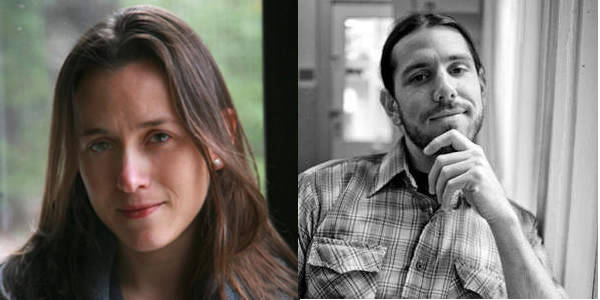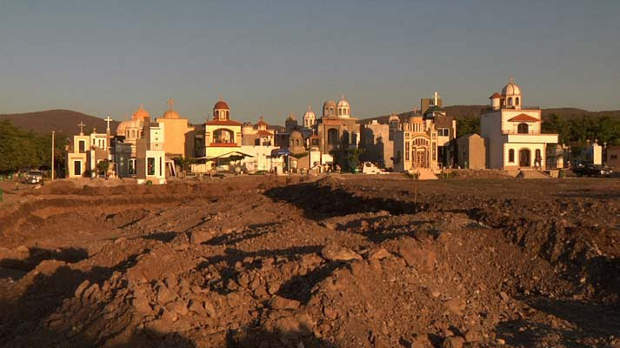 Back to selection
Back to selection
POV @ 25: Natalia Almada & Theo Rigby on Technology in Docs

In celebration of the 25th season of PBS’ groundbreaking documentary series POV, Filmmaker is this week running a four-part conversation series between two non-fiction directors with close ties to the show. A few weeks ago, award-winning documentarian Natalia Almada — whose new film, El Velador, airs tonight as part of the 2012 POV season — and Sin País director Theo Rigby, a photographer-turned-filmmaker, sat down to talk about a variety of issues that arise from their work. Through the course of the discussion, Almada and Rigby share where they’ve been, where they are now, and where they’re heading while dissecting different viewpoints of their craft.
In this final part, Almada and Rigby talk about technology’s role in documentary filmmaking.
Rigby: Coming into filmmaking full-force the past three to five years, technology and digital technology have exponentially grown since then. But I’ve worked on film as well and it’s such a different experience that I really value. I look at a short I made in grad school with fifteen minutes of 16mm black and white film—and one of the three-minute rolls got scratched so I actually had twelve minutes of film that I shot. It ended up being a six-minute short and many people watch it and say, “Wow, there was so much in those six minutes that this was a more fulfilling experience than feature films that I’ve watched.” And I think the care and attention and the amount that I’ve prepared or even preconceived of what the film would look like or say, is a really powerful thing.
In terms of the digital revolution going on, I’m experimenting right now. My new project is a series of short films that I’m not going to make in the context of having in a movie theater, in the dark with a feature length, but rather watching in a different way whether it’s online or in an installation. I’m trying to figure out how that works and how to tell stories as a filmmaker in that form and how these pieces live out in the world. I’m trying to take the whole digital advance conundrum and figure out what pieces are really powerful and what power is specific to that medium.
Almada: Yeah, I feel like that’s a really common trend at the moment. I think there’s pressure and I’m reading a lot of grant proposals lately and it seems like a lot of them will say, “I’m not just making a film. I have a transmedia project.” There’s this idea and there are two sides. There are some interesting projects that really look at new ways that we can look at film and new contexts—whether the installation or through the internet or however it is.
I think on the not-so-good side, there’s pressure from a lot of the funders and broadcasters, etc. to create this kind of second set of product to accompany the film. It’s fine that it exists, but sometimes it’s not the place of the filmmaker to produce it and distract from their process of making a good film; and I don’t think the same media can just go one place or another. I think the other crossover is the art world and film world—for example, Steve McQueen made himself as a artist but is now making feature films, and there are people going the other way. I’ve done some of this work as well where you recut a film and make it work as an installation.
I think at best, it’s interesting when the change of space creates a different contract with the audience and playing with how you can adjust what you’re doing to work with a new contract. It’s not the same—you know when you put a movie on TV, it’s not the same agreement as having them come and sit in a theater for an hour and a half.
I think those contracts are all interesting and we say, “Oh, video’s definitely changed,” but I won’t say more than anything how much media gets made and often there’s a lot of junk out there—which is great in some ways and not great in others. We forget that there was a whole group of great documentary filmmakers that went out there and worked alone. They didn’t have big crews because they were working on 16mm, so sometimes what we do isn’t that new in that aspect as we think it is. People think in general that you could never make a film just one person working. But people definitely did and made beautiful films. Films that we came out of like a Fred Wiseman or the Maysles brothers, and many others.
Rigby: I agree with a lot of what you just said and it’s true that we often seek that transmedia component that adds something—often the feature film is finished and it’s just tacked on in a way. And refitted for something that wasn’t intended. And there’s pressure from funders to add extras. I’m coming at it from the other way where it’s transmedia from the start and there’s no feature film, there’s no app. It is a piece as is.
It still kind of makes people’s eyes cross sometimes. They don’t really get it, but I’m at somewhat early stages and a lot of more traditional funders are hesitant to jump in the water that right off the bat is exploring that new medium rather than taking a known quality of a feature film and reforming it to fit that space.
Almada: You just have to go to different funders. Just don’t go to the film funders. [laughs] You need to go to the arts or somewhere else because with the film funders there’s no interest in something they can’t sell tickets to or broadcast. I think the art world has more of that kind of thing, whatever you want to call it. They work in a different context.
Rigby: It is exciting because with this project you go on this platform and tell your own immigration story and connects to the whole immigration and genealogy world—which some people say is the number one hobby of America. So it’s pushing me in a lot of different directions and pushing me out of the filmmaker bubble and into worlds like technology where filmmakers don’t normally go. The funding is pushing me to be this whole website platform. But I think the documentary film world can grab this question in an interesting way, whereas traditional film funders know there’s a future that has to happen, but they don’t necessarily know how to support filmmakers in the way that would really take advantage of the media and not be a tack-on piece.
Almada: It’s like mixing apples and oranges. It’s not going to end film or the way things have been done. It’s just something different and the confusion of the two is what the problem is. It’s great that it exists but let it be what it is, and let films be film. We still want to go to the cinema. I would hate to think that everything is moving in that direction and the time of sitting with 250 people in a packed cinema is over. They’re totally unrelated to me and the confusion would come if they were thought to be inextricable and you had to have these big platforms to make your film successful. But it’s the same way with funding and pushing for measurable outcome, and that pressure of what the film is going to do so they can go back to their funders and say, “Look, we made a film that did this,” and that makes it valid. To be a film for the sake of being a film is not enough and I find that a frustrating environment to work in.
Rigby: And it’s a scary environment you just outlined to work in. I think for me personally, it’s spending a good amount of time on my computer and the whole digital revolution, if anything, has made the theatrical film experience for me even more profound; because coming out of the feature-length film that you connected with people in the dark is such a unique experience. It can never be replicated watching a piece on a computer by yourself. Other things can happen, but that theatrical experience can’t happen and I cherish that experience. If anything I’ve been going to see more and more movies in the theaters these days as I spend more time on the computer in this digital world.

